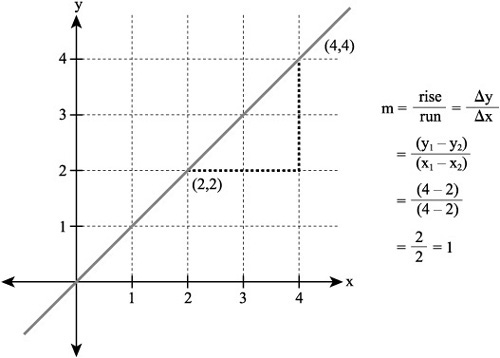The Point-Slope Equation
The previous sections reveals that if you start with the y-intercept and the slope of a line, you can generate additional coordinate sets. When you determine points in this way, you work with differences between the two sets of coordinates (the deltas). As Figure 6.11 illustrates, you can always employ the differences you find between the run and rise values of two coordinates to calculate the slope of the line. At the same time, you can make use of a given point along with the slope to determine the position of another point.
Figure 6.11. The slope remains a ratio between the rise and the run of a line.

To examine relating the point to the differences of the values of two points, consider that if you take the ratio shown in Figure 6.11, you develop this equation. On the top, you present the ratio and the slope:

When you rewrite the equation in the second form, the result is known as the point-slope equation. This equation gives a formal definition to the notion that if you know the coordinates of a point on a line and the slope of the line, then you can create an equation for the line.
Consider the line shown in Figure 6.12.
Figure 6.12. Two points allow you to create an equation.

Given the points in the graph featured in Figure 6.12, you can determine the slope if you substitute coordinate values into the point-slope equation:
![]()
Note
It is important to retain a specific ordering of the coordinate values when you determine the slope. Figure 6.13 illustrates a situation in which the order of the x coordinates is the reverse of the order of the y coordinates:
Figure 6.13. Preserve the order of the pairs.

When you know the slope of the line that connects the two points, you can proceed to find the equation of the line. To accomplish this, you make use of the point-slope equation. This equation reads as follows:
(y2 – y1) = m(x2 – x1)
You now substitute the slope and values from one of the coordinate pairs. Using the values from Figure 6.12, this leaves you with this form of the equation:
y – (5) = 2(x – 1)
If you solve for y, you arrive at the standard form of a linear equation:
y – 5 = 2(x – 1)
y = 2x – 2 + 5
y = 2x + 3
This, then, is the equation for the line shown in Figure 6.12.
